Search Results for: silk
How to Make a Tassel – Making Silk and Embroidery Floss Tassels Video
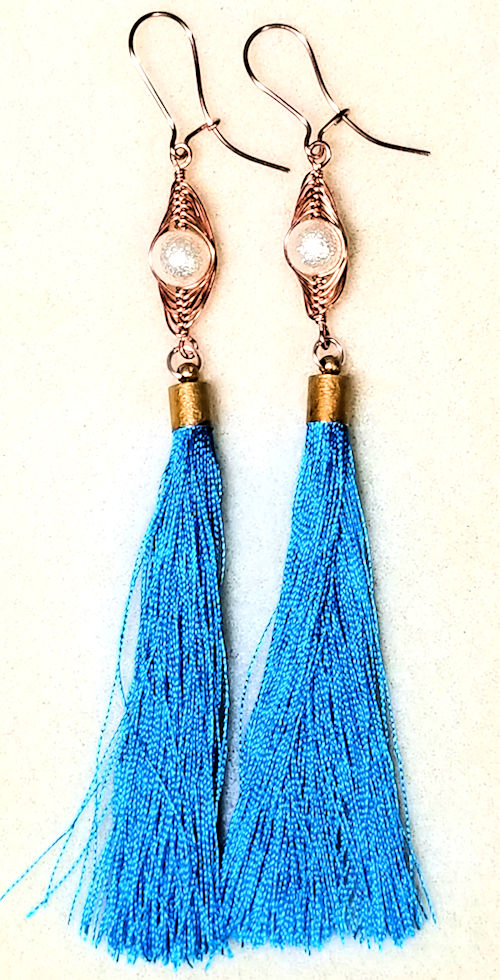 How to make a tassel – this video has some instructions and insights into the fun jewelry art of tassel-making! I’ve seen a lot of jewelry lately featuring tassels – especially silk. Sooooo, I got some silk, rounded up some embroidery floss and embarked on the tassel-making journey.
How to make a tassel – this video has some instructions and insights into the fun jewelry art of tassel-making! I’ve seen a lot of jewelry lately featuring tassels – especially silk. Sooooo, I got some silk, rounded up some embroidery floss and embarked on the tassel-making journey.
Then, I thought, why stop there? What about some other beading threads I had laying around — how would they work? Well, I pulled out some of those and tried them out — with various success, as you will see, LOL.
Why Make a Tassel?
Why make a tassel? I guess the question is why not make some? I’ll admit, I never quite saw the charm of them, until I realized how comfortable they are for earrings — very lightweight, when made with silk. You can get those shoulder-dusters without pulling down your earlobes. I don’t know about you, but I’m sensitive to heavy earrings; I have a hard time with them, so I gravitate to smaller ones. Well, problem solved!
Uses for Tassels — They Aren’t Just for Jewelry
I’ll admit, I mostly use them for jewelry. But in making the video and trying out different kinds of thread, I wondered what else they might be used with.
Some obvious items would be chain pulls and edging for lamps. Pillows too — they could use a tassel edging. But what about Christmas tree ornaments? I can see them hanging down, either attached to some regular glass balls, or on their own.
Small tassels could be used for key rings, although I’d probably use leather for those.
What about adding them to tote bags, either as a stand-alone or maybe all around the edges? And of course there is the option to add a tassel as a “charm” to your handbag.
Oh, and I forgot about adding them as accents to your drapes — that is another use that has been in vogue.
Still, my favorites are jewelry — but then again, a lot of what I am and do is somehow related to jewelry. 🙂
Video Tutorial – Get Comfy and Get Watching
OK, so here’s the video. And in case you were wondering, the end caps I used were either 4mm (smaller tassles) or 8mm (tassel with the charm). I got a boatload of them from Amazon for a very inexpensive price — like $10 or so. Since they are all the same shape, I’m working on ways to alter them so they become part of the jewelry, instead of just something to hold the tassel. But — that’s a whole other video!
https://youtu.be/L3xVHjDxSUI
Bead Embroidery Bracelet – “Gypsy’s Silk”
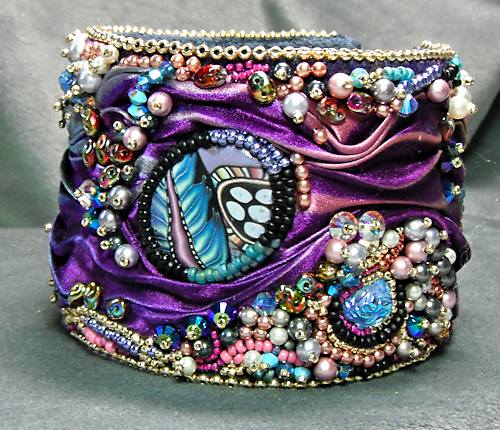 Every time I take a bead embroidery class, I come away full of new ideas. A couple of weeks ago I took a couple of classes with Sherry Serafini (who, by the way, is as awesome a teacher as she is a beader), and this is the result of one of the classes. I call this bead embroidery bracelet “Gypsy’s Silk”.
Every time I take a bead embroidery class, I come away full of new ideas. A couple of weeks ago I took a couple of classes with Sherry Serafini (who, by the way, is as awesome a teacher as she is a beader), and this is the result of one of the classes. I call this bead embroidery bracelet “Gypsy’s Silk”.
A Different Look
You’ll notice that this is a little different from most bead embroidery; it’s closer to being mixed media. Then again, bead embroidery really is mixed media in a way, since you are beading on some type of fabric or backing.
The difference with this is that silk is being used as part of the bracelet. It’s a type called Shibori, and it’s gorgeous! I am not sure if the silk is pleated, then dyed, or dyed before pleating. Either way, it’s beautiful, as well as intriguing to work with.
So, I have to give Sherry the credit for thinking up this beautiful new style of bead embroidery. But it’s also given me ideas for taking this a step in a different direction. Which means that I have a whole slew of new projects percolating for my upcoming “Bead Embroidery Components 2” tutorial.
Where’s the Shibori Silk?
While the Shibori silk ribbon in the bracelet above I bought from Sherry (I fell in love with the colors), I had also bought some online from Etsy (one of my favorite places) that was a bit more muted. But at the class, I discovered that one of my classmates also sold Shibori ribbon, so click here for her site – she has absolutely gorgeous colors too. (And no, I don’t get a commission for recommending her — I just saw with my own eyes what she had with her, so I know it’s wonderful.)
Big and Beautiful (If I Say So Myself)
This is a really wide cuff — a little over 2 inches. But it takes a surprisingly short time to complete. Of course, part of that is due to the fact that the ribbon takes up a fair amount of space that would normally be covered by beads. But, that was my idea — Sherry’s demo piece had less silk showing. But since I have never been one to color between the lines, I took my piece in a little different direction.
So that’s “Gypsy’s Silk”. I had a really hard time naming this piece, but it seems to fit. Well, I think so at any rate. So, off to the races (so to speak) and I’ll start getting together my next Bead Embroidery Components 2 tutorial — and it will be far more “bling-y” than Intro to Bead Embroidery Components.
So, hope you like this piece, and see you later! 🙂
Quick Guide to Czech Bead Shapes – Two Hole Beads
Two hole beads have come a long way since I bought my first tube of SuperDuo beads. Now when it comes to “playtime”, we have all kinds of options. You can use them by themselves, or along with your favorite seed or other beads. Want even more fun? Mix different sizes and shapes!
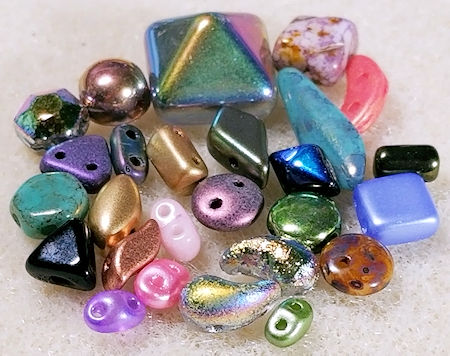
Just a Few Two Hole Czech Beads
When shopping for these beads, you’ll typically see them as “Czech seed beads” or “Czech beads” or “CzechMates”.  Supposedly the sizes of the CzechMates are more standardized, so they work well together — they used to be just 6mm on the longest side. However, there are other sizes in the CzechMate family now, so the lines are getting blurred.
I was originally making this one large post, but then I realized how very long it was! So, I am splitting this into three posts — two holes, one hole and three of more holes. (I’ll link them as soon as I have the other posts up.)
This post will be about the various two-hole shapes that are out there, with their sizes. I’ll list them in alphabetic order.
- Amos par Puca: These are pear-shaped beads, with the two holes running through the sides. 5mm x 8mm.
- Arcos par Puca: Three holes, these are crescent-shaped, with the holes running along the side of the bead. Size is 5mm x 10mm.
- Bar: Two holes, these are typically used as a spacer. The beads resemble a flattened oval, with the holes running horizontally. Size is 2mm x 6mm.
- Baroque Cabochon: Two holes. This is a cabochon shape, but the curved top has a baroque pearl kine of look. The two holes are parallel through the bottom. 7mm diameter at the bottom.
- Bi-Bo: These are similar to SuperDuo beads, but the centers are concave instead of convex. Approximately 5.5mm x 3mm in size.
- Brick: Similar to Bar beads, but these are more rectangular. The size is 3mm x 5mm.
- Cabochon: Two holes. These beads have flat backs and a domed top. They kind of remind me of gumdrops! 4.5mm x 6mm. I’ve also seen them in a 7mm diameter.
- Carrier: Two holes. New to the market (at the time of this writing), they are much larger than the standard two-hole beads. They are more pillow-shaped — thinner on the ends, thicker across the middle. Intriguing, as I’ve yet to buy and try them. They are 9mm x 17mm.
- Crescent: Two holes. Similar to Arcos par Puca, but the holes are on the face of the bead, instead of through the side. 2mm x 10mm in size.
- Dagger: Two holes or one hole, these are very much like regular dagger beads. 5mm x 16mm.
- DiamondDuo: Two hole beads, these are diamond-shaped. One side is flat, and the other is lightly faceted.  5mm x 8mm.
- DiscDuo: Two holes. These are flat lentil-ish, bit with the holes through the narrower side of the bead. Approximately 4mm x 6mm.
- GemDuo: Very much like the DiamondDuo, but the side that isn’t flat has more of a rounded profile, as opposed to faceted. Approximately 8mm x 5mm.
- Half Moon: Similar to the Crescent beads, but instead of having a curve on both sides, the curve is on one side, while the other is flat. They are also a bit smaller in size. The holes are on the face of the bead. 4mm x 8mm.
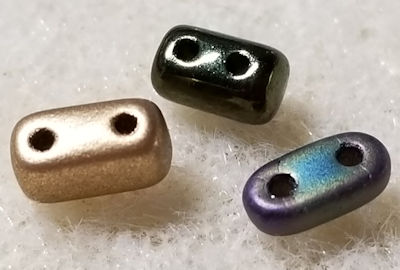
Bar, Brick and Rulla
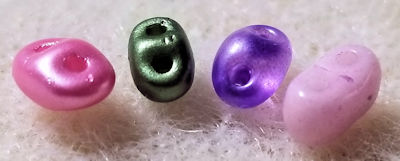
SuperDuo, MiniDuo, Twin and Bi-Bo
- HoneyComb: These beads have the two holes runningthrough the narrower side of the bead. Both the top and bottom are flat. And of course, they are six-sided and look like a honeycomb! 3mm x 6mm.
- HoneyComb Jewel: The same as the regular two-hole HoneyComb, but these are faceted on one side. Roughly 4mm x 6mm in size (the facets make it a little bit thicker).
- Ios par Puca: Very similar to the Bar beads, they also have a rounded top and bottom, but with straight sides. Size is 2.5mm x 5.5mm.
- IrisDuo: Two holes. These are a smooth marquise in shape, and the holes are parallel through the sides. 4mm x 7mm.
- Kite: Two holes. Similar to the DiamondDuo, but these have more of a kite shape than a diamond shape. 5mm x 9mm.
- Kheops par Puca: Interesting triangle bead. Two holes, which run vertically from base to tip. Both top and bottom are flat. Size is 3mm x 6mm.
- Lentil: Two holes. These have a puffed disc shape, and the holes are on the flatter sides. Size is 3mm x 6mm.
- MiniDuo: Two holes, these are like SuperDuos, just a little smaller. Same shape, but the size is 2mm x 4mm.
- Nib-Bit: Two holes. These remind me of flattened gumdrops on steroids, LOL. Think of them as a very tall cabochon, but instead of the holes being at the bottom of the bead, they are parallel through the sides. 5mm x 6mm.
- PaisleyDuo: These are paisley-shaped as you might imagine. The top and bottom are flat, and the holes run parallel though the sides. Because the top and bottom are flat, they can be used as both right facing and left-facing (i.e., which direction the tail points). 5mm x 8mm.
- Piggy: Lentil beads, but instead of the holes being even spaced on either side, one is in the center and the other is off to the side. They are also slightly larger, with a size of 4mm x 8mm.
- Pyramid: Think of these as a pyramid, except instead of having only 6 facets, these have 6 facets. The holes are parallel through the bottom. 12mm.
- RounDuo: Two holes with a slightly off-round shape (which you may not really notice unless you put them next to some really round beads, like glass pearls). Size is 5mm.
- Rulla: Two holes, these are like Bar beads, but rounded on the front and back. The sides that have the holes (which run horizontally) are flattened. Size is 3mm x 5mm.
- Silky: These are two hole tile-shaped beads, flat on one side and with a “puff” on the other. The holes on this bead run diagonally. 4mm x 6mm.
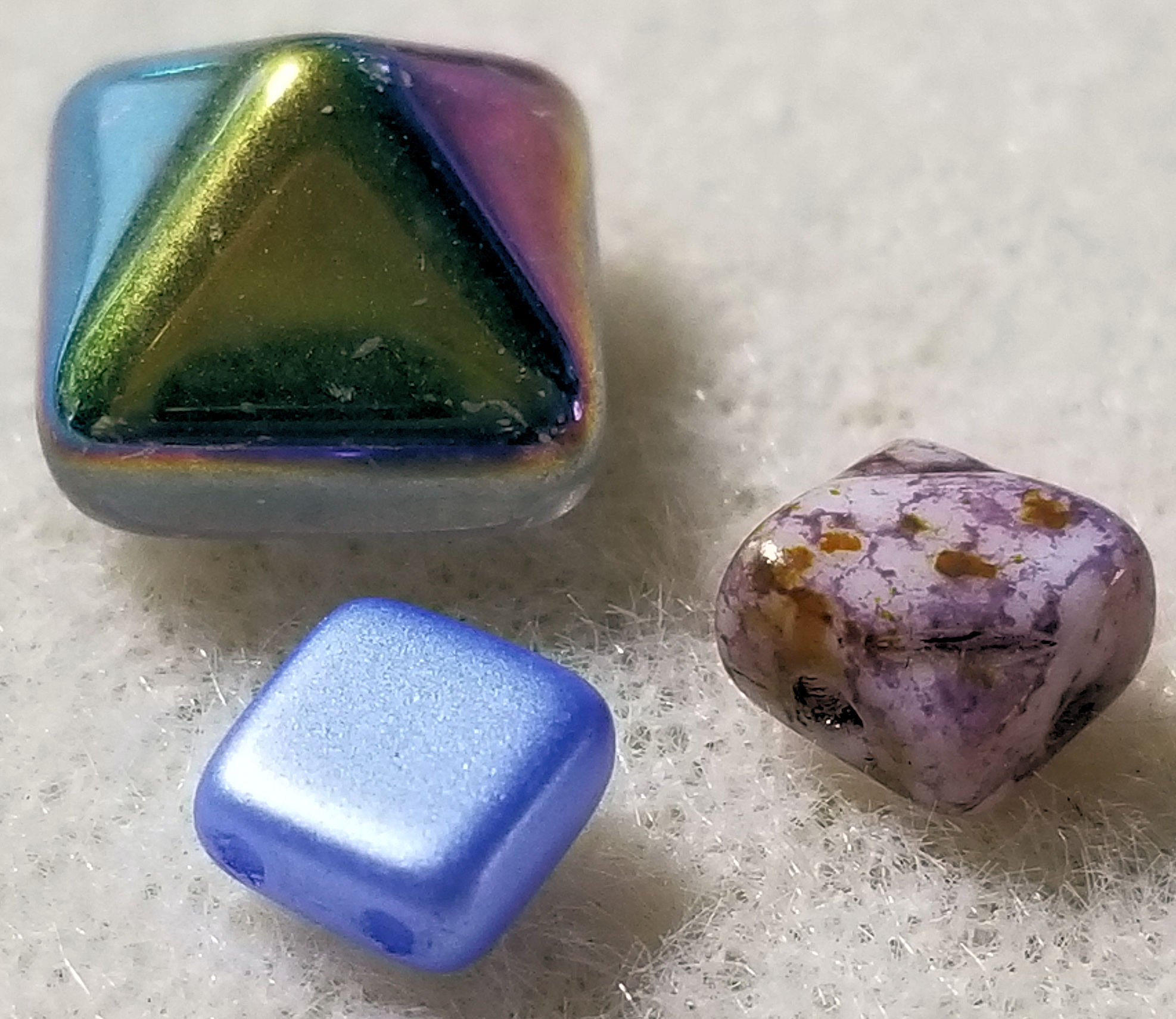
Stud (Pyramid), Silky and Tile
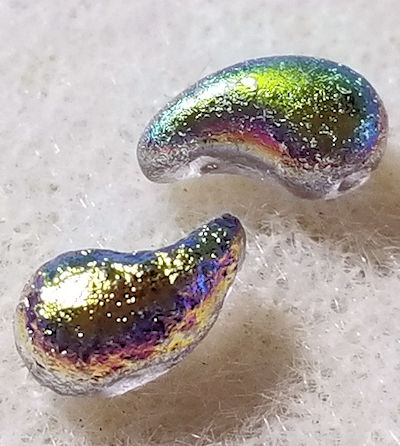
ZoliDuo Beads, Left and Right
- Stud: Two holes, with one flat side and the other with four facets, meeting up to a gently rounded point. I’ve seen these in both 6mm and 8.5mm x 12mm sizes, but the 12mm size is most common.
- SuperDuo: Two-holes, these are probably the best known and most popular of the two hole beads. Somewhat of a tapered oval, gently rounded with a slight “pinch” in the center. 2mm x 5mm.
- Super Kheops par Puca: These are the regular Kheops par Puca, but closer to a pyramid-type bead. 6mm.
- Tile: These are flat square beads, with the two holes running horizontally. Size is 3mm x 6mm.
- Triangle: Two holes. These are flat, thin beads, with the holes at the bottom.  2mm x 6mm.
- Twin: Two holes. Very much like the SuperDuo, but a little more rounded and every so slightly thicker. 2.5mm x 5mm. It’s easy to mistake these for SuperDuos.
- ZoliDuos: These are paisley-shaped, like the PaisleyDuos. The difference is that the ZoliDuos have one side that’s flat and one that is rounded.  In any case, because both sides are’t flat, they come in both a right side and a left side — there is definitely a difference in the way the tail points, so when you buy these, make sure to get both left and right versions. 5mm x 8mm.
These are the ones that either I have, or at least have seen at the time of this writing. There are even more out there, because new ones seem to pop up each day. And I have undoubtedly missed some on this list!
Interested in how to use these beads in projects? Check out my Youtube playlist for two-hole beads!